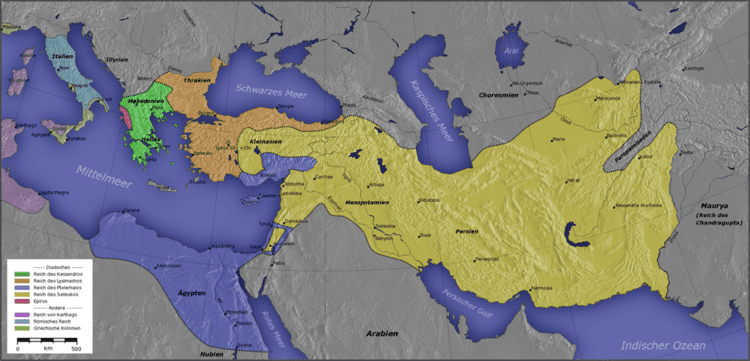64 BC–135 AD → Founded 64 BC | ||
 | ||
Syria was an early Roman province, annexed to the Roman Republic in 64 BC by Pompey in the Third Mithridatic War, following the defeat of Armenian King Tigranes the Great. Following the partition of the Herodian Kingdom into tetrarchies in 6 AD, it was gradually absorbed into Roman provinces, with Roman Syria annexing Iturea and Trachonitis. Later, in 135 AD, in the aftermath of the Bar Kokhba revolt, Syrian province was merged with Judea province, creating the larger province of Syria Palaestina.
Contents
Provincia Syria
During the Principate.
Creation of Syria Palæstina
Syria Palæstina was established by the merger of Roman Syria and Roman Jud(a)ea, following the defeat of the Bar Kokhba Revolt in 135. The Syrian army took part in the quelling of the revolt in 132-136, and in the aftermath, the emperor Hadrian added the greatly depopulated province of Judea to the province of Syria thus forming Syria-Palaestina.
Provincia Syria-Coele
The governor of Syria retained the civil administration of the whole large province undiminished, and held for long alone in all Asia a command of the first rank. It was only in the course of the second century that a diminution of his prerogatives occurred, when Hadrian took one of the four legions from the governor of Syria and handed it over to the governor of Palestine. It was Severus who at length withdrew the first place in the Roman military hierarchy from the Syrian governor. After having subdued the province (which had wished at that time to make Niger emperor, as it had formerly done with its governor Vespasian) amidst resistance from the capital Antioch in particular, he ordained its partition into a northern and a southern half, and gave to the governor of the former, which was called Coele-Syria, two legions, to the governor of the latter, the province of Syro-Phoenicia, one legion.
Phoenice
The emperor Septimius Severus divided up Roman Syria in the fashion it would remain until the rule of the Tetrarchs. Under his reign it was divided into three parts, Coele Syria in the north with Antioch as its provincial capital, Syria Phoenice with Tyre as the provincial capital and in the south Syria Palestina with Caesarea Maritima as the provincial capital. From the later 2nd century, the Roman senate included several notable Syrians, including Claudius Pompeianus and Avidius Cassius.
Syria was of crucial strategic importance during the crisis of the third century.
In 244 AD, Rome was ruled by a native Syrian from Philippopolis (modern day Shahba) in the province of Arabia Petraea. The emperor was Marcus Iulius Philippus, more commonly known as Philip the Arab. Philip became the 33rd emperor of Rome upon its millennial celebration.
Roman Syria was invaded in 252/253 (the date is disputed) after a Roman field army was destroyed in the battle of Barbalissos by the King of Persia Shapur I which left the Euphrates river unguarded and the region was pillaged by the Persians.
In 259/260 a similar event happened when Shapur I again defeated a Roman field army and captured the Roman emperor, Valerian, alive at the battle of Edessa. Again Roman Syria suffered as cities were captured, sacked and pillaged.
From 268 to 273, Syria was part of the breakaway Palmyrene Empire.
Dominate reform
Following the reforms of Diocletian, Syria Coele became part of the Diocese of Oriens. Sometime between 330 and 350 (likely c. 341), the province of Euphratensis was created out of the territory of Syria Coele along the western bank of the Euphrates and the former realm of Commagene, with Hierapolis as its capital.
Syria in the Byzantine Empire
After c. 415 Syria Coele was further subdivided into Syria I (or Syria Prima), with the capital remaining at Antioch, and Syria II (Syria Secunda) or Syria Salutaris, with capital at Apamea on the Orontes. In 528, Justinian I carved out the small coastal province Theodorias out of territory from both provinces.
The region remained one of the most important provinces of the Byzantine Empire. It was occupied by the Sassanids between 609 and 628, then recovered by the emperor Heraclius, but lost again to the advancing Muslims after the battle of Yarmouk and the fall of Antioch. The city of Antioch was recovered in 963 AD along with many other parts of the country. A reconquest undertaken by the Fatimad caliphate in the 970s retook most parts of Syria from the Byzantines. However, the Byzantine emperor Basil II reconquered all of Syria from Muslims by 1000 AD. Frequent rebellions, however, weakened Byzantine control over Syria. By 1045 only the city of Antioch remained Byzantine. Ultimately the Turks took Antioch in 1084. Antioch was recovered again in the 12th century. However, by that time the city was regarded as part of Asia Minor and not Syria. (See History of the Byzantine Empire.)
Episcopal sees
Ancient episcopal sees of the late Roman province of Syria Prima (I) listed in the Annuario Pontificio as titular sees:
Ancient episcopal sees of the late Roman province of Syria Secunda (II) listed in the Annuario Pontificio as titular sees:
